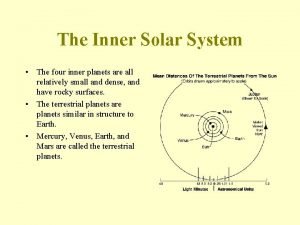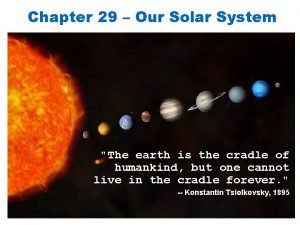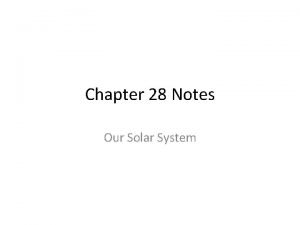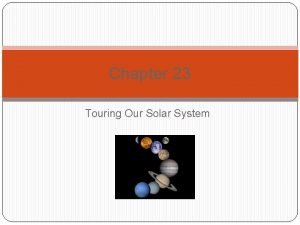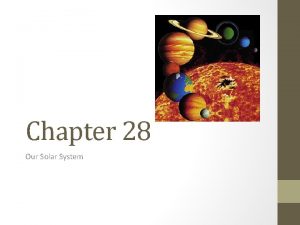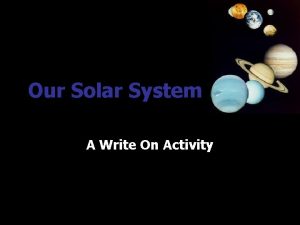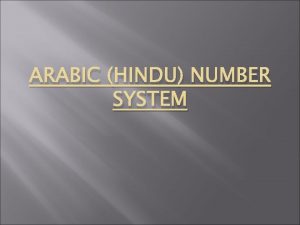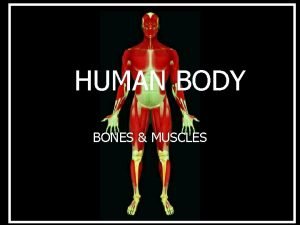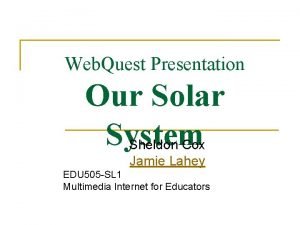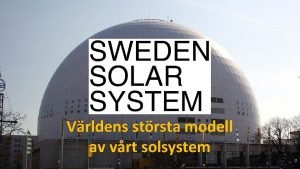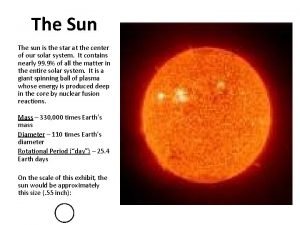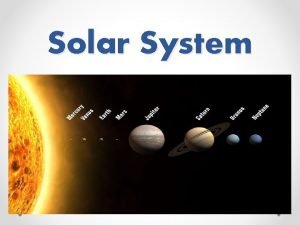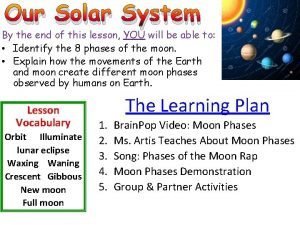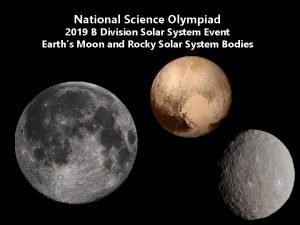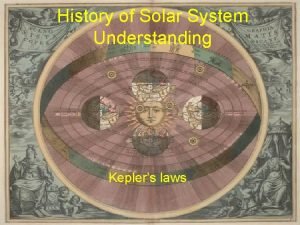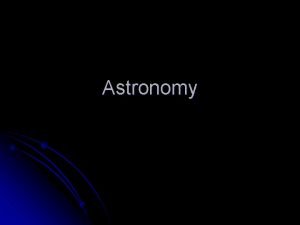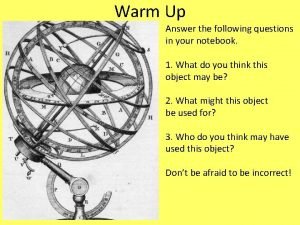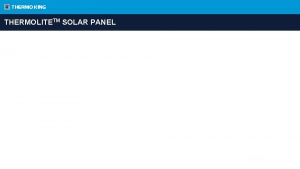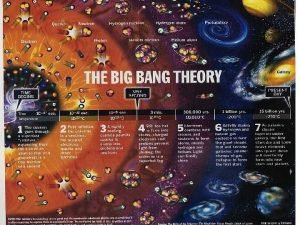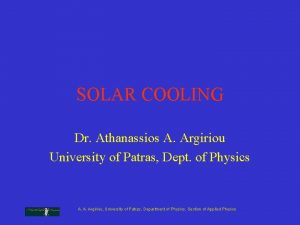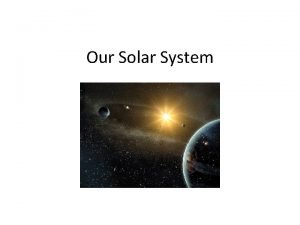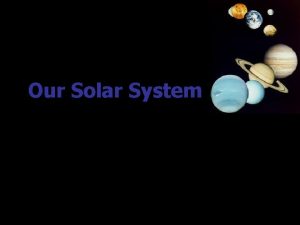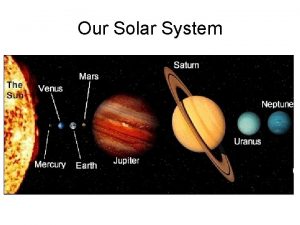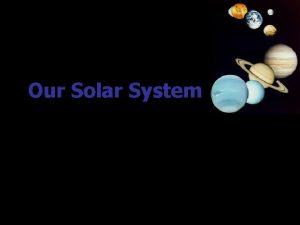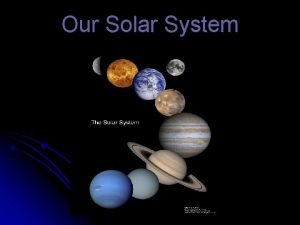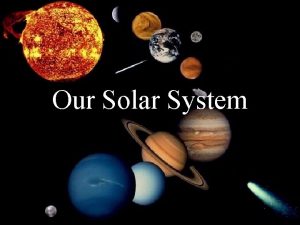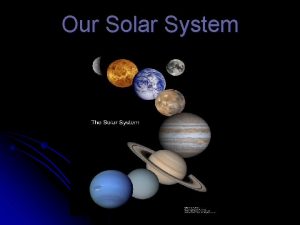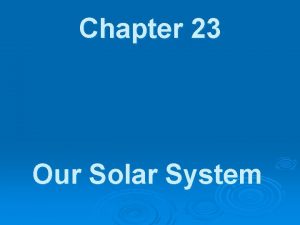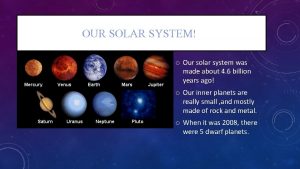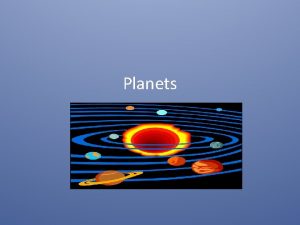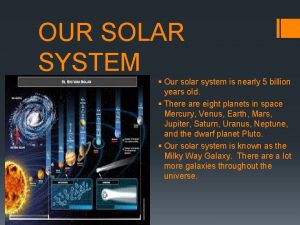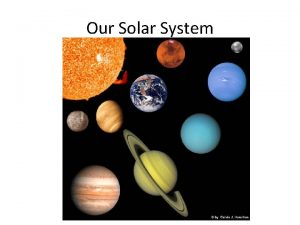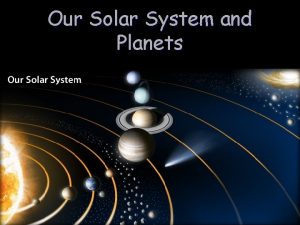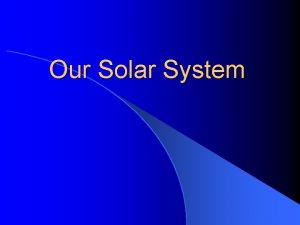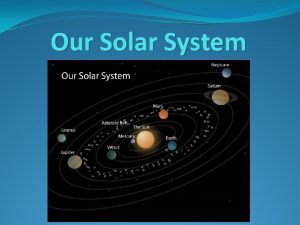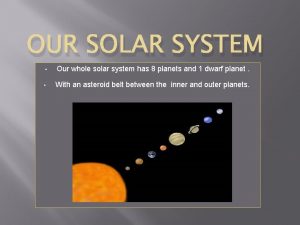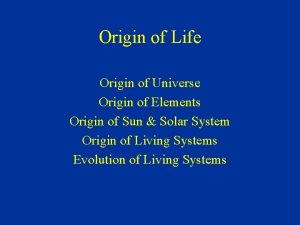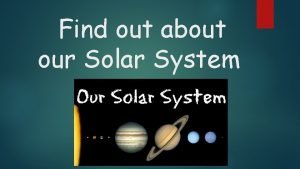the origin of the solar system Our Solar




















































































- Slides: 84

the origin of the solar system

Our Solar System consists of… • the sun at its center • eight planets, circling around the sun • moons • asteroids • and comets.

a review of the origin of matter • the mass of our planet (and you and me) was made w/i about 3 minutes of the Creation Event • then atoms were only H and He • w/i about a billion years stars and galaxies come to be (but no rocky planets at all)

• the stars is where all the rest of the elements bigger than H and He was made ≤Fe • the elements >Fe were made in supernovae (which is why those elements are rare) • how they all got into a planet and into you is what this lecture is all about

the origin of planets • there are two processes to consider here: catastrophes and evolution • catastrophes are sudden “life changing” events (e. g. supernovae, impacts, marriage) • evolution here is just change over a period of time, nothing sudden about it

• we’ll see here that the origin and life of planets is not either/or, but a combo of both • e. g. possibly 2 local supernovae (c) started the condensation of local gas and dust (e) to form a disk of gas and dust called a… • solar nebula which we see all over the place…

CONDENSATION/ACCRETION • a cloud of dust and gas collapses due to gravity • it forms a “pizza dough” disk • the new sun blows away excess debris • stuff that has had time to accrete remains as planets

Condensation/Accretion • In the beginning, our Solar System was a huge disc of dirt, rocks, dust, gas, ice etc. • In the middle of this disc, the Sun formed due to gravitational pressure until fusion commenced and it began to glow. • At a distance from the center, the planets accreted from these rings of dirt, rock, dust and gas. • The rocky terrestrial planets coalesced closer to the sun out of denser/heavier materials. • The gaseous Jovian giants coalesced further from the sun where it was cold enough for the light elements like hydrogen, helium, and methane to condense.

planets orbiting other stars • if solar nebula theory is good, there’d better be extrasolar planets out there • but finding them is a pain: they’re too close to their star, ultra-dim, small, far… • several evidences that they exist: dust and wobbles and light drops…

• beta Pictoris is the most well known of the dust disk stars • it has a huge cold disk (100 x bigger than our solar system) and a hole in the middle, just like our solar system has • planets may have already formed in the hole

• and here young stars are surrounded by disks of gas and dust • are there new planets being formed here? ? ?

• in Orion we see protostars with dust but no center clearing yet • are planets forming here now?

• and then there’s wobble • a planet orbiting a star can cause it to wobble just slightly

• first seen in 51 Pegasus 10+ years ago • have seen 1000 s now, but • most are quite large and close to parent star

• and we have ever-so-slight dimming of star light implying tiny planets are moving in front of a star

• and we can see tiny Doppler effects from a star’s spectrum implying something small and reflecting star light is moving about up there

A survey of the solar system • here we look at the significant characteristics, and clues to how it formed • and we’ll begin to see what a miracle this place is…

• our solar system is mostly empty space (good) • if our sun were a ping pong ball in this room, Pluto would be a speck of dust on the football field • all the other planets would be sand seed sized at various distances between • = almost entirely empty

Size & Distance • Imagine the Solar System being a football field (about 100 m long). • The sun would be a glowing orange in the center. • Pluto would encircle the sun at the edge of the soccer ground, having the size of a dust particle. • The Earth would be 1. 3 m away from the “orange“, having the size of a sesame seed.

Scaled Down…

revolution and rotation • overall we’re pretty darn flat; Mercury is tipped (7˚), Pluto even more (>17˚) (= clues)

• we all go around the sun in the same direction (= clue)

• and all spin in the same direction as well (= clue), except… • Venus is spinning backwards(!), Uranus & Pluto on their side • all this helps us understand how they all formed

two kinds of planets • here is a big clue to how it all came about • there are inner: earthlike - terrestrial - planets… • and the more distant outer: jupiterlike - jovian - planets

• notice three things following: 1. the two kinds of planets are distinguished by their location 2. there is a great difference in mass and density 3. there are craters everywhere! • all these are clues!


clue

clue

clue

space debris asteroids, comets, meteoroids… • only three types: • these little guys are some of the remnants of the earliest days

• asteroids (minor planets) are found mostly between Mars and Jupiter • >20, 000 known, but perhaps billions more (can’t be seen) • about 1000 have orbits that take them to inner solar system • many found in other special orbits


• have actually flown by a few and seen that even they have tiny impact craters in them • were the ones b/t M and J (@ 2. 8 AU) the debris of a broken up planet or a planet that never formed?

• comets are the best known and prettiest of space junk • small nucleus just km across can produce a tail >AU! • as the rocky ice ball comes close to the sun, its ices boil away and dust is released

• the solar winds push the gases and dust into an enormous tail away from the sun • are they just icy mudballs? ? ? • one way or another they are made of the earliest stuff of the solar system and are a clue to it all

• here is dust from comets which help give us meteor showers

• meteors are here and gone (aka shooting stars) • they are just ~sand-sized bits of stuff which vaporize when they hit our atmosphere, lighting up the air as they do • we put on about 40, 000 tons a year from this space debris

• meteor is the streak of light in the atmosphere • meteoroid is the object itself

• meteorites are those big enough to make it to the ground • almost never does it make it through • but those that do can tell us how old the solar system is!

the age of the solar system • we use half-life to help us here • radioactive elements found on Earth, Moon, and meteorites can be examined to see the ratios of parent to daughter • this helps us determine how long these things have been solidified

• earliest rocks on Earth are ~4. 4 billion years old • but Earth is constantly recycling so oldest ones may never be found!!! : ( • the Apollo landings found Moon rocks that dated to 4. 48 billion years old • Martian rocks that have made it here date to ~4. 5 billion years ago

• meteorites have a wide range as well but the oldest are ~4. 6 billion years old • we kind of cheat with the sun’s age @ 5 billion years • we assume it is 5 billion because no rocks date older than that, but! • computer models agree with that age • here’s all the evidence so far…


the story of planet building • here astronomers have to take the evidence and solar nebula theory to find out how it all may have happened…

the chemical composition of the solar nebula • the composition of the early times can still be seen on the sun’s surface: 73% H, 25% He, 2% heavy elements • we think the planets started by sticking tiny bits of elements and molecules into bigger bits

• only when a planet gets to about 15 earthmasses does it have enough gravity to steal H and He from the solar nebula • gravitational collapse occurs increased density, pressure… • J and S did this quickly, U and N more slowly (and U and N were at the outskirts which may mean some of their building blocks were blown away by the sun’s brothers and sisters) • This process actually heats the planet up! (J & S still hot)

• so what happened with the terrestrials? • they were too small to hold onto lightweight H and He : ( • they are dense b/c they formed from the heavier elements • but how did it all happen? a two step process…

the condensation of solids • why dense inners, and light outers? • all has to do with the way gases condense in those regions… • near the new hot sun only heavier elements like silicates and metals could condense at all • further out where it’s cooler, lighter elements could condense • way out there water ice, methane, and ammonia could be used as bldg blocks


• all this is called a condensation sequence • it’s probably even more complicated than this (e. g. the nebula probably cooled as time went by) but however it happened the process was perfect


the formation of planetesimals • three processes at work here: 1. grains of stuff accumulate to bigger things (cms kms) 2. bigger clumps (kms) called planetesimals collect into planets 3. the solar nebula clears up

• the little guys grow in two ways: condensation and accretion • condensation is like the formation of a snowflake, small stuff runs into bigger stuff and sticks to make bigger stuff

• bigger things could stick to each other by electrostatic attraction, or polar molecules, or chemical bonding, or other forces such as gravity! • like building a snowman from the snowflakes • called accretion

• big accreted guys could be brought to a growing thin disk and concentrate there; gas and tiny dust particles couldn’t • speeds up planet-making! a

• see in this meteorite all the tiny grains of stuff all stuck together

• see in this meteorite all the bigger bits of stuff all stuck together

• new computer models show that this disk is unstable, that little eddies would have formed • this further concentrates stuff; now we have particles growing from cm’s tiny planets…


the growth of protoplanets • thankfully, all the clumps of stuff is moving in the same direction so they don’t annihilate each other • in fact, this helps them grow bigger! • chemical adhesive forces and electrostatic cling still let this stuff hold on to each other, to be sure, but • gravity plays a huge role in holding it all together

• and now even small impacts might help: • by getting smacked, a little layer of dust might form • the layer of dust could act like a trap • and getting bigger means more gravity means better able to hold onto a very thin atmosphere • now can be considered a protoplanet

• now this big homogeneous ball begins to heat up (b/c of gravitational pressure and radioactive decay) • as it melts, the heavy stuff (Ni & Fe) falls toward center; lighter silicates float to top • = differentiation • the heat causes outgassing; the driving out of gases trapped in rocks • makes early atmosphere!!!

• a slight variation says this: • as the solar nebula cooled, the metals condensed first • as the solar nebula cooled more, the silicates could condense onto the metal-based planets

• an even better theory says the planets formed quickly and that as they condensed the heat of condensation helped differentiate the planetary layers as they formed • which actually happened? we don’t know.






• way out there in the extreme cold the jovians quickly swept up gases as part of their makeup • they probably formed pretty quickly (< 10 million years) • [recent computer models show jovian types can form in just a couple revolutions! only hundreds of years!] • the terrestrials took ~30 million years • all over within 100 million years

explaining the characteristics of the solar system • let’s look at the clues and see how they are explained… • whole solar system disk shaped? ü b/c solar nebulae do that (gravity & centrifugation) • sun and planets rotate and revolve in same direction? ü b/c all formed from same disk • all planets on same plane? ü b/c the solar nebula collapsed into a disk

• what about Venus & Uranus & Pluto? ü catastrophes! planet collision, though rare, are possible and probably knocked Venus and Uranus around • even we were probably hit by another planet (--> moon)

• why terrestrial/jovian difference? ü the condensation process (inside and hot condense only metals/silicates; outside and cold can condense water and other gases to build planets) • and more material means more planet

ü grow to ~15 earth-massee and you get to vacuum up gases in the solar-nebula (jovians) ü also, Jupiter’s gravity was probably responsible for preventing the formation of a planet between it and Mars ü those planetesimals are still there as the asteroid belt

ü comets are the icy planetesimals leftovers from the outer solar system ü the multitude of moons could have been formed from mini solar nebs around the planets, or… ü may have been captured space debris

ü the great distances of the jovians make it easier for them to hold onto their ring of debris ü and their ages all agree with a common birth date ü and the asteroids, comets, and meteorites are explained as left-overs from the solar nebula

clearing the nebula

• look up in the night sky and it’s pretty clear! • what happened to the solar nebula? • it vanished when sun was young; but how?

• radiation pressure! • when the sun got luminous enough, its radiation’s interaction with matter could literally push tiny specks and atoms right out of solar system

• solar wind!!! • the flow of ionized stuff from the sun, the sun’s breeze, pushes the dust and gas out, as well

• vacuum effect: • the planets, as they grew, swept up the bigger stuff with their gravity • look at the surfaces of the planets and satellites and asteroids • there are millions of impacts

• and most of them date from ~4 billion years ago • this was the time of heavy bombardment • we still get hit but not like the rain of old

• ejection • little stuff can whip around big guys and be tossed from the solar system • jovians were very effective here (and still are)

• the wonderfully orchestrated set of events that led from the Creation Event to the formation of the solar system can be fairly well explained
 What are the four inner planets
What are the four inner planets Chapter 29 our solar system
Chapter 29 our solar system Chapter 28 our solar system
Chapter 28 our solar system Chapter 23 touring our solar system
Chapter 23 touring our solar system Chapter 28 our solar system
Chapter 28 our solar system What are the inner planets
What are the inner planets [email protected]
[email protected] Our solar system
Our solar system Thinking language and intelligence
Thinking language and intelligence Our census our future
Our census our future Christ, be our light
Christ, be our light Marcus aurelius our life is what our thoughts make it
Marcus aurelius our life is what our thoughts make it We bow our hearts
We bow our hearts Our census our future
Our census our future Our life is what our thoughts make it
Our life is what our thoughts make it Money madness summary stanza wise explanation
Money madness summary stanza wise explanation Awareness of ourselves and our environment is:
Awareness of ourselves and our environment is: Our awareness of ourselves and our environment
Our awareness of ourselves and our environment God our father christ our brother
God our father christ our brother Our future is in our hands quotes
Our future is in our hands quotes Our awareness of ourselves and our environment.
Our awareness of ourselves and our environment. Awareness of ourselves and our environment is
Awareness of ourselves and our environment is Wholesale solar power panels
Wholesale solar power panels An inexhaustible source of energy
An inexhaustible source of energy Hindu numbers
Hindu numbers Hình ảnh bộ gõ cơ thể búng tay
Hình ảnh bộ gõ cơ thể búng tay Lp html
Lp html Bổ thể
Bổ thể Tỉ lệ cơ thể trẻ em
Tỉ lệ cơ thể trẻ em Voi kéo gỗ như thế nào
Voi kéo gỗ như thế nào Chụp tư thế worms-breton
Chụp tư thế worms-breton Hát lên người ơi alleluia
Hát lên người ơi alleluia Môn thể thao bắt đầu bằng từ đua
Môn thể thao bắt đầu bằng từ đua Thế nào là hệ số cao nhất
Thế nào là hệ số cao nhất Các châu lục và đại dương trên thế giới
Các châu lục và đại dương trên thế giới Cong thức tính động năng
Cong thức tính động năng Trời xanh đây là của chúng ta thể thơ
Trời xanh đây là của chúng ta thể thơ Mật thư tọa độ 5x5
Mật thư tọa độ 5x5 Phép trừ bù
Phép trừ bù Phản ứng thế ankan
Phản ứng thế ankan Các châu lục và đại dương trên thế giới
Các châu lục và đại dương trên thế giới Thể thơ truyền thống
Thể thơ truyền thống Quá trình desamine hóa có thể tạo ra
Quá trình desamine hóa có thể tạo ra Một số thể thơ truyền thống
Một số thể thơ truyền thống Cái miệng bé xinh thế chỉ nói điều hay thôi
Cái miệng bé xinh thế chỉ nói điều hay thôi Vẽ hình chiếu vuông góc của vật thể sau
Vẽ hình chiếu vuông góc của vật thể sau Thế nào là sự mỏi cơ
Thế nào là sự mỏi cơ đặc điểm cơ thể của người tối cổ
đặc điểm cơ thể của người tối cổ Thế nào là giọng cùng tên? *
Thế nào là giọng cùng tên? * Vẽ hình chiếu đứng bằng cạnh của vật thể
Vẽ hình chiếu đứng bằng cạnh của vật thể Fecboak
Fecboak Thẻ vin
Thẻ vin đại từ thay thế
đại từ thay thế điện thế nghỉ
điện thế nghỉ Tư thế ngồi viết
Tư thế ngồi viết Diễn thế sinh thái là
Diễn thế sinh thái là Các loại đột biến cấu trúc nhiễm sắc thể
Các loại đột biến cấu trúc nhiễm sắc thể Bảng số nguyên tố lớn hơn 1000
Bảng số nguyên tố lớn hơn 1000 Tư thế ngồi viết
Tư thế ngồi viết Lời thề hippocrates
Lời thề hippocrates Thiếu nhi thế giới liên hoan
Thiếu nhi thế giới liên hoan ưu thế lai là gì
ưu thế lai là gì Khi nào hổ mẹ dạy hổ con săn mồi
Khi nào hổ mẹ dạy hổ con săn mồi Khi nào hổ con có thể sống độc lập
Khi nào hổ con có thể sống độc lập Hệ hô hấp
Hệ hô hấp Từ ngữ thể hiện lòng nhân hậu
Từ ngữ thể hiện lòng nhân hậu Thế nào là mạng điện lắp đặt kiểu nổi
Thế nào là mạng điện lắp đặt kiểu nổi The system which gives a definite shape to our body is
The system which gives a definite shape to our body is Digestive system image
Digestive system image Solar system webquest answer
Solar system webquest answer Solsystemet globen
Solsystemet globen How far is venus from the sun in miles
How far is venus from the sun in miles Formation of the solar system comic strip
Formation of the solar system comic strip Dual sun solar system
Dual sun solar system Outer solar system brainpop answers
Outer solar system brainpop answers Solar system science olympiad
Solar system science olympiad Kepler's model of the solar system
Kepler's model of the solar system Make me genius solar system
Make me genius solar system Kepler's model of the solar system
Kepler's model of the solar system Where is the solar system located in the milky way
Where is the solar system located in the milky way Thermolite solar panels
Thermolite solar panels Is venus terrestrial or gaseous
Is venus terrestrial or gaseous Redshift and blueshift
Redshift and blueshift What separates the inner planets and outer planets
What separates the inner planets and outer planets Solar cooling system
Solar cooling system
